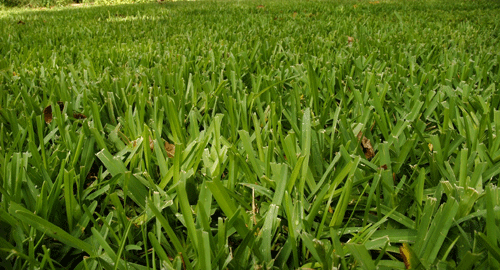St. Augustine grass (Stenotaphrum secundatum), like Bermuda, is a favorite of the warmer climates. It is native to the tropics and is commonly grown along the fringes of swamps and seashores in the United States.
St. Augustine doesn’t tolerate poorly drained soils very well, nor does it do well in extreme drought or freezing temperatures. It does, however tolerate a wide rage of pH (5.0 to 8.5) as well as higher soil salinity than does bermudagrass, making it a desirable turf near coastlines.It spreads by above ground shoots (stolons) and is usually established by sod or plugs.
(Note: The ProPlugger 5-IN-1 is not recommended for plugging St. Augustine grass due to its’ loose structure of roots and runners (rhizomes/stolons).
St Augustine Leaf Texture
Coarse.
Where St Augustine Thrives
St. Augustine is a warm season grass that grows best in the warm, mostly humid regions of the United States (to USDA Hardiness Zone 9), particularly along the coasts.
When to Plant St Augustine
St. Augustine sod and plugs establish best under warm conditions (80º-100º F) so care should be taken not to plant in late fall. Plant St. Augustine plugs or sod in late spring as temperatures warm and up until late summer (90 days prior to the first frost date in cooler regions).
Light Requirements
St. Augustine grass thrives best in full sun, but can tolerate light shade. Thinning can occur in grass grown in shady areas of the lawn.
Watering Requirements
All grasses need to be watered daily during establishment using sod (or plugs cut from sod). Using plugs grown in trays or transplanted plugs from donor areas of the lawn require less frequent watering as more mature root systems are in place. Once established, St Augustine does not need frequent watering except in extended drought conditions. A bluish-grey color and/or curled or wilted leaves are an indication that watering is needed.
Planting Methods
While St Augustine seed is available, establishment using seed if very difficult. Extremely slow to germinate, St Augustine seed also suffers from low germination rates, both of which lead to weed crowding issues during establishment. For best results plant St. Augustine grass by plugs or sod.
Soil Preparation
The best way to grow a nice lawn is to properly prepare the soil for planting, which begins with understanding the importance of soil pH and having your soil tested. The 5-IN-1 Planting Tool can be used to quickly pull soil samples from various locations in your lawn area. Whether you’re planting St Augustine from plugs or sod, the finished surface should contain four to six inches of quality topsoil, free of stones and large clumps of soil. Use a tiller to work up the topsoil and smooth it out with a garden rake.
Fertilizing St. Augustine
After having your soil tested, preferably in the fall, add phosphorus and potassium based on the results of the soil analysis. For best results, add these macro nutrients in the fall to give them time to work their way down into the top soil. Nitrogen can be added in spring after St Augustine begins to green up. Cease fertilizing in late summer in preparation for winter dormancy.
Insects and Disease
Be on the lookout for these insects: chinch bugs, sod webworms and white grubs. This turf grass is susceptible to a number of fungus diseases, including brownpatch, gray leaf spot, and down mildew. Contact your local extension agent on tips and products to control insects and disease in turf grass. Disease problems are managed mostly by good cultural practices, i.e., mowing, watering and feeding.
St. Augustine Varieties
Floratam, Palmetto, Seville, Sapphire and Bitterblue (all with improved insect and disease tolerance).
Neil Moran is a horticulturist and author of three books on gardening. He is also the creator and author of the garden blog North Country Gardener

